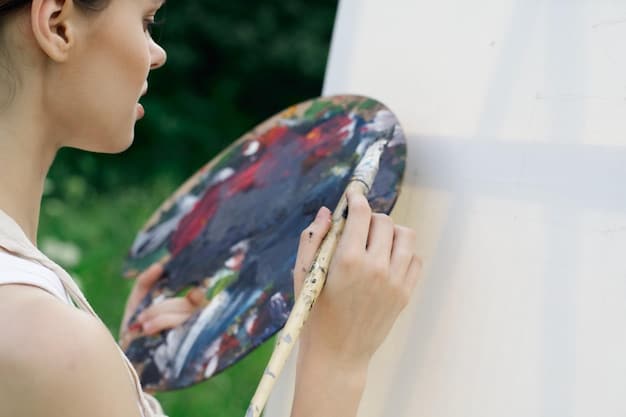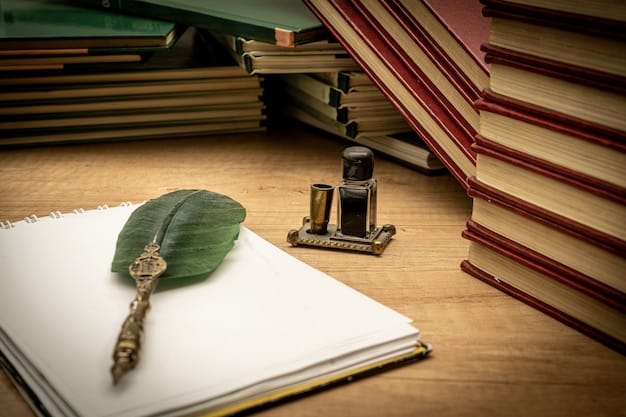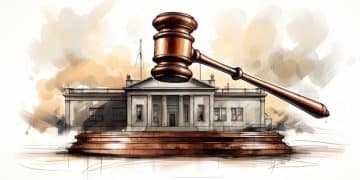How to Protect Your Intellectual Property as a US Artist: A Legal Guide

Protecting intellectual property is crucial for US artists; this guide covers copyrights, trademarks, patents, and trade secrets, offering practical steps and legal insights to safeguard creative work.
Navigating the legal landscape of art can be daunting, especially when it comes to safeguarding your creative output. This guide, How to Protect Your Intellectual Property as a US Artist: A Legal Guide, breaks down the essentials you need to know to protect your work.
Understanding Intellectual Property Rights for Artists
Intellectual property (IP) rights are the cornerstone of protecting artistic creations. Understanding these rights is the first step in ensuring that your work is legally safeguarded and that you, as the artist, retain control over its use and distribution.
Copyright Law and Artistic Creations
Copyright is a legal right granted to the creators of original works of authorship, including artistic, literary, dramatic, musical, and certain other intellectual works. This provides exclusive rights to the copyright holder, typically the artist, to control how their work is reproduced, distributed, and displayed.
Trademarking Your Art: Branding and Recognition
While copyright protects the artwork itself, a trademark protects symbols, names, and designs used to identify and distinguish your art brand or unique style. This is particularly important for artists who create a recognizable brand associated with their work.

Here are key steps to consider for artists in the US:
- Register Your Copyrights: Officially register significant works with the U.S. Copyright Office.
- Monitor and Enforce Your Rights: Regularly check for unauthorized uses of your work online and offline.
- Trademark Your Brand: If your art has a distinct brand, trademark your logo and name.
When artists actively manage and protect their intellectual property, they not only retain control over their creations but also build a sustainable and scalable career.
Copyright Protection for Visual Artists in the US
Copyright protection is automatically granted to original works of authorship once they are fixed in a tangible medium, such as a painting, sculpture, photograph, or digital artwork. However, understanding the nuances of copyright law is crucial for visual artists seeking comprehensive protection.
Copyright protection offers several exclusive rights to the artist:
- The right to reproduce the work.
- The right to create derivative works.
- The right to distribute copies of the work.
- The right to publicly display the work.
Registering your works and understanding copyright law is fundamental to protecting your artistic rights.
Using Trademarks to Protect Your Artistic Brand
For artists seeking to brand themselves or their unique artistic style, trademarks offer a powerful tool for protection. A trademark is a symbol, design, or phrase legally registered to represent a company or product, and it can be applied to an artist’s brand to distinguish their work in the marketplace.
Here are a few scenarios where trademarking may be necessary:
- Protecting Your Artist Name: If you use a unique artist name, trademarking it can prevent others from using it in a way that could confuse or dilute your brand.
- Branding Your Style: If you have a distinct artistic style that is recognizable, you might consider trademarking elements of that style.
- Protecting Merchandise: If you sell merchandise featuring your artwork, trademarking your logo or brand name ensures exclusivity.
By using trademarks wisely, artists can solidify their brand and prevent others from profiting from their reputation and style.

Contracts and Agreements: Protecting Your Work in Collaborations
Collaboration is a common practice in the art world, but it can also lead to disputes about intellectual property ownership if not properly managed. Clear contracts and agreements are crucial for protecting your work when collaborating with other artists, galleries, or clients.
Here are a few things that are important to note:
- Define Ownership: The agreement should clearly state who owns the intellectual property rights to the collaborative work.
- Specify Usage Rights: The contract should outline how each party can use the collaborative work, including reproduction, distribution, and modification rights.
- Include Termination Clauses: Agreements should include clauses that specify how the collaboration can be terminated and what happens to the intellectual property rights upon termination.
Clearly defining the terms of collaboration and ownership in a contract can prevent misunderstandings and ensure that your intellectual property rights are protected.
Digital Age Challenges: Online Copyright Infringement
The digital age has opened up new avenues for artists to share and sell their work, but it has also created new challenges in protecting intellectual property online. Copyright infringement is rampant on the internet, with unauthorized reproductions, distributions, and adaptations of artistic works being commonplace.
Here are key steps to protecting your work online:
- Monitor Your Work Online: Use tools like Google Alerts and TinEye to track where your artwork is appearing online.
- Issue DMCA Takedown Notices: If you find your work being used without permission, send a Digital Millennium Copyright Act (DMCA) takedown notice to the website owner or hosting provider.
- Consider Watermarking: Adding a watermark to your digital images can deter unauthorized use and make it easier to track infringements.
Being vigilant about monitoring and protecting your work online is essential for preserving your intellectual property rights and preventing financial losses.
Seeking Legal Counsel: When to Consult an IP Attorney
While this guide provides a general overview of intellectual property protection for artists in the US, it is no substitute for legal advice. There are situations where consulting an IP attorney is highly recommended to ensure your rights are fully protected.
You should seek legal assistance if you encounter situations such as:
- Complex Licensing Agreements: If you are entering into complex licensing agreements with third parties, an attorney can help you understand the terms and negotiate favorable conditions.
- Copyright Infringement Disputes: If you encounter significant copyright infringement, particularly involving commercial use of your work, an attorney can help you pursue legal action.
- Trademark Disputes: If you are involved in a trademark dispute, either as the plaintiff or defendant, an attorney can represent your interests and help you navigate the legal proceedings.
Consulting an IP attorney can be a valuable investment in protecting your artistic career and ensuring that your intellectual property rights are secure.
| Key Aspect | Brief Description |
|---|---|
| ©️ Copyright Protection | Secures original artistic works, providing exclusive rights to reproduce, distribute, and display the art. |
| ™️ Trademarking Your Brand | Protects your artist name, logo, and unique style, distinguishing your brand in the market. |
| 🤝 Contracts & Agreements | Defines ownership and usage rights in collaborations to prevent disputes and safeguard your work. |
| 🌐 Online Protection | Monitors online use, issues DMCA takedowns, and uses watermarks to combat digital copyright infringement. |
Frequently Asked Questions (FAQ)
▼
The first step is to ensure your work is original and then fix it in a tangible form, like a painting or digital file. This automatically grants you copyright protection, but consider registering it with the U.S. Copyright Office for stronger legal standing.
▼
Copyright protects original artistic works, while a trademark protects brand identifiers like your artist name or logo. Copyright prevents unauthorized copying, whereas a trademark prevents others from using similar marks that could confuse consumers.
▼
A collaboration contract should explicitly state ownership of the intellectual property, specify each party’s usage rights, and include termination clauses outlining what happens to the rights if the collaboration ends.
▼
A DMCA takedown notice is a legal notification sent to a website owner or hosting provider, demanding they remove content that infringes on your copyright. It’s based on the Digital Millennium Copyright Act.
▼
Consult an IP attorney when dealing with complex licensing, facing significant copyright infringement, or involved in a trademark dispute. Legal advice ensures your rights are fully protected and that you navigate legal proceedings effectively.
Conclusion
Protecting your intellectual property is crucial for every US artist. By understanding copyrights, trademarks, contracts, and online protections, and knowing when to seek legal counsel, you can safeguard your creative work and build a sustainable artistic career.





